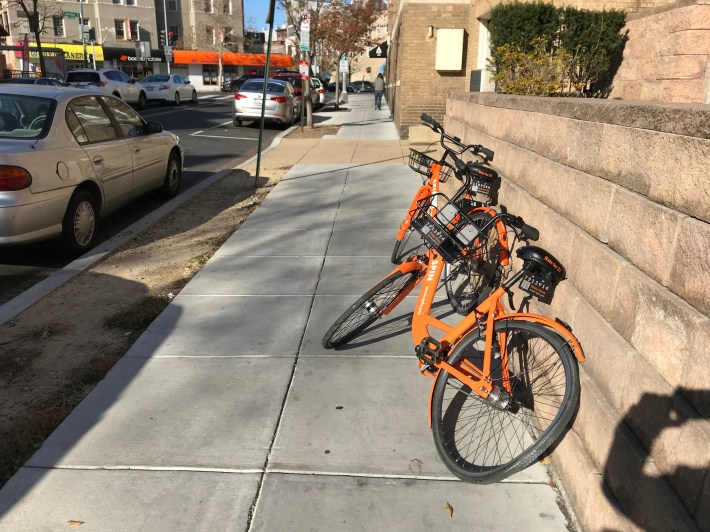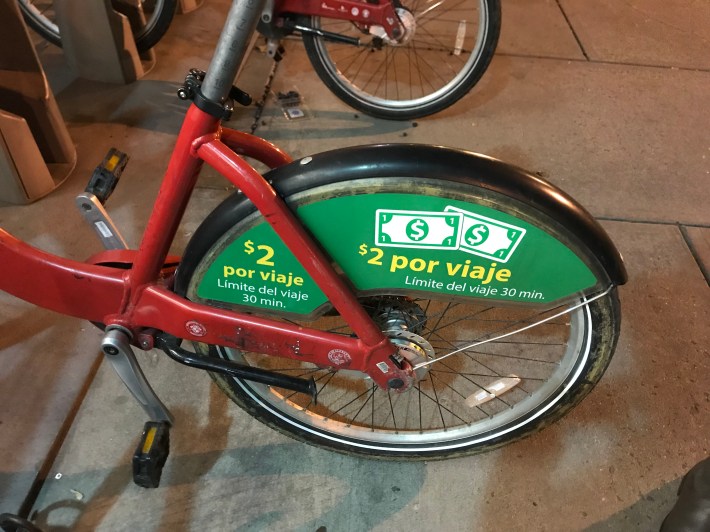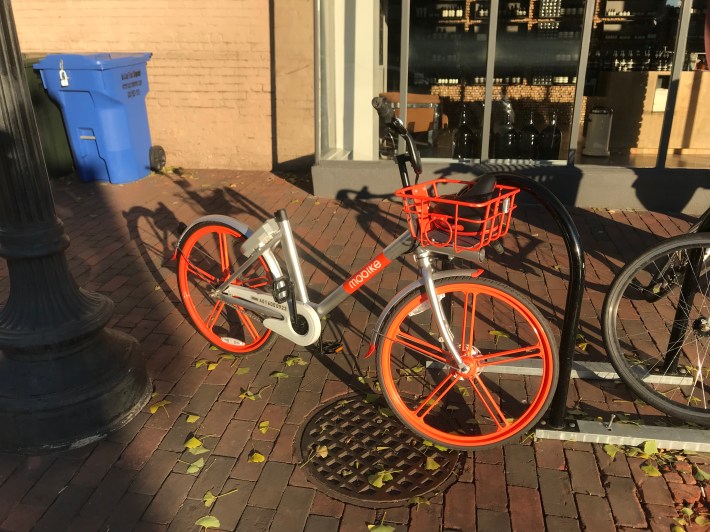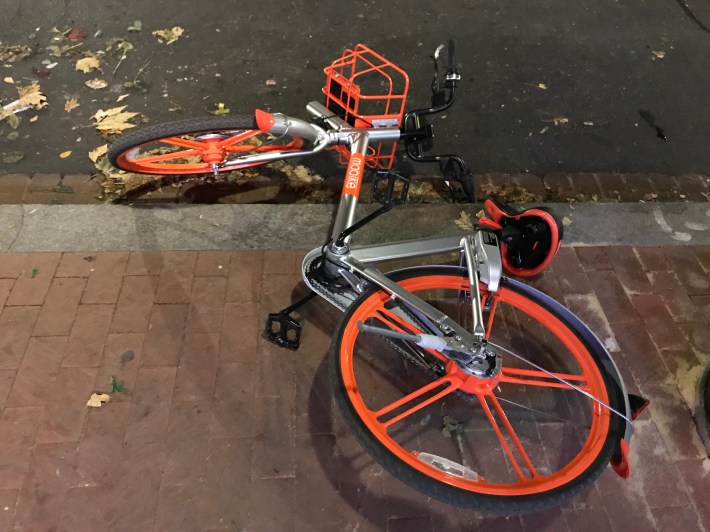Last week I spent Thanksgiving in Washington D.C., one of the nation’s leading laboratories for dockless bike-share, aka DoBi. This new technology does away with expensive docking stations used by traditional bike-share systems like Chicago’s Divvy, and allows users to locate and unlock bikes with a cell phone app, and then leave them right at their destination.
Before the trip, I was already aware of some of the pros and cons of the dockless trend. On the plus side, the bikes are cheap to use – typically $1 for a half-hour ride. Unlike most docked networks, you don’t get penalized with ever-increasing late fees for keeping a cycle for more than the designated ride increment (30 minutes in Chicago), since each additional half hour is only another buck. Therefore, casual users don’t have to commit to a 24-hour pass, as is the case with Divvy, which charges $9.95 for a day pass. In addition, less planning is required, since you don’t need to locate a station to end you trip.

On the other hand, since the bikes are usually secured with a wheel lock and not attached to a fixed object, it’s possible to park them in ways that create hazards for pedestrians. As Twitter feeds like the Seattle-based Dockless Bike Fail hilariously illustrate, vandals and pranksters can also leave them hanging from signs or trees, or even throw them in bodies of water.
While the multitude of DoBi companies, many of them based in China, aren’t reliant on taxpayer dollars, like many traditional systems are, they’re propped up by millions or even billions of dollars in venture capital. Combined with the fact that the companies don’t have to install stations, this makes it easy for them to undercut public systems on pricing. Unlike Divvy, D.C.’s Capital Bikeshare does sell single rides, but they cost $2 for 30 minutes, twice as much as a typical dockless ride.

Similar to how ride-hailing companies have disrupted public transit and the taxi industry, it’s possible that DoBi could kill off successful docked systems and then have to jack up their rates, or even go out of business themselves, after the venture capital dries up. And, like Uber, some dockless companies have engaged in shady businesses practices, such as releasing fleets of bikes in cities and on college campuses where it’s not legal to do so, or dumping hundreds or thousands of cycles in cities without maintaining them, which has resulted in massive bike graveyards in some Chinese cities. And then there’s the CEO of the Chinese company BlueGoGo, who recently disappeared with millions of dollars in customer security deposits shortly before the business declared bankruptcy.
But I tried to keep an open mind as I checked out the different dockless systems in D.C., the first good-sized city with a flourishing traditional network to allow DoBi operators to set up shop. MoBike, LimeBike, Spin, Ofo, and Jump (which rents electrical-assist cycles) have each been permitted to release 400 cycles in the District, creating a rainbow of bike-share choices.
I downloaded all five of the apps, which was pretty straightforward even for a relative Luddite like myself. Locating the bikes was a little trickier, since the applications didn’t always accurately show the positions of the cycles, but it seemed like you could usually find a few “free-locked” vehicles near transit stations and along busy retail strips. Most of the D.C. dockless systems allow you to unlock a bike by using your smartphone to scan a QR code displayed on various places on the cycle.

I had a chance to check out MoBike, LimeBike, and Ofo cycles, which were a bit lighter than the steeds used in the Divvy, CaBi, and New York City’s Citi Bike docked systems, which are all run by the same company, Motivate. The DoBi bikes I tried also seemed to be a bit shoddier – in a few cases the headlights and baskets had become detached. The ride also wasn’t quite as smooth and stable as a Divvy, but I found the dockless bikes I tried to be reasonably comfortable and agile.

The fully functional front baskets on the dockless cycles are also a big improvement over the front racks of the Motivate bikes, which are really only designed for briefcases and purses, although you can squeeze a backpack into one. Having a real basket came in handy when I had to carry home a bag of pupusas after meeting up with former Streetsblog USA editor Tanya Snyder, now covering national transportation issues for Politico, and her kids at one of the Mount Pleasant neighborhood’s many Salvadoran restaurants.
Not having to worry about late fines while riding also makes a big difference in the rider experience. It’s a lot more relaxing to ride without constantly having to pay attention to the time, knowing that each additional 30 minutes will only cost another dollar.
Being able to leave your bike right at your destination is another huge perk – it’s always a little annoying when you have to walk a few minutes to or from Divvy stations. It’s also great that with dockless you aren’t confined to a service area defined by station locations. For example, the Thanksgiving morning Turkey Trot I ran in D.C.’s Crestwood community (my knees are still sore) took place outside of the CaBi zone, but taking DoBi to the starting line was an option.
Moreover, badly parked DoBi bikes seemed to be the exception rather than the rule. While I saw a few cycles lying on the ground or partially blocking the pedestrian right-of-way, most were standing on their kickstands on the parkway, often next to private bikes locked to racks. I didn’t encounter the type of bike parking fugazi regularly featured on Dockless Bike Fail.

So after experiencing DoBi firsthand, I’m convinced that the technology could be a positive addition to the Chicago bike scene, especially during an era in which future federal funding to expand the Divvy system to outlying neighborhoods may be hard to come by. But assuming that the city of Chicago eventually lets dockless providers do business here, it’s going to crucial to come up with and enforce rules and regulations on parking and maintenance, ensure that the bikes serve all neighborhoods, not just profitable high-demand areas, and take steps to make sure that DoBi doesn’t pull the rug out from under Divvy.
With that in mind, here’s a simple proposal. Chicago recently passed a new fee on ride-hailing trips, with the revenue earmarked for CTA infrastructure. How about taxing future dockless providers in our city and using that money to purchase more Divvy stations for neighborhoods that don’t have them yet?





